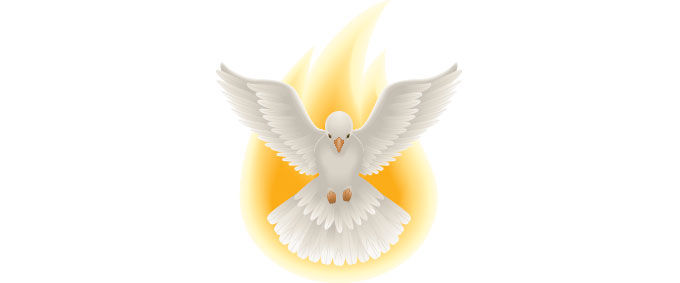Symbols of the Holy Spirit

In our churches, religious art, and liturgical prayers, we use a variety of symbols to represent the Holy Spirit, all of which come from the Bible. Here are some of those symbols.
One of the most common symbols of the Holy Spirit is a dove. It comes from the story of Jesus’ baptism, when Jesus saw “the Spirit, like a dove, descending upon him.” (Mark 1:10) The other three Gospel writers use similar wording to describe the event (see Matthew 3:16, Luke 3:22, and John 1:32).
Fire is another popular representation of the Holy Spirit. The fire that appeared on Pentecost (Acts of the Apostles 2:3) was reminiscent of the burning bush on Mount Sinai from which God spoke to Moses. (Exodus 3:2) During the Exodus, the people of God were led by a pillar of fire at night. (Exodus 13:21) Fire calls attention to the strength and force of the Holy Spirit.
The Holy Spirit is also represented by wind. In fact, the original Hebrew and Greek words for “Spirit” can be translated as “wind.” The wind that appeared on Pentecost (Acts of the Apostles 2:2) was reminiscent of the wind that blew over the waters at the beginning of Creation. (Genesis 1:2) The wind calls attention to the Holy Spirit breathing life into the Church.
Water signifies birth and life. From a faith perspective, it represents the cleansing and life-giving action of the Holy Spirit at Baptism. (Matthew 3:11; John 3:5) The symbolism of water is addressed in the Catechism of the Catholic Church (#694):
As “by one Spirit we were all baptized,” so we are also “made to drink of one Spirit.” (1 Cor 12:13) Thus the Spirit is also personally the living water welling up from Christ crucified (Jn 19:34; 1 Jn 5:8) as its source and welling up in us to eternal life. (Cf. Jn 4:10-14; 7:38; Ex 17:1-6; Isa 55:1; Zech 14:8; 1 Cor 10:4; Rev 21:6; 22:17)
The cloud is used as a symbol of the Holy Spirit because clouds provide life-giving water. In the Old Testament, God often leads his people with a cloud or appears to them in a cloud. (Exodus 16:10) The image of a cloud is often combined with the image of light to symbolize the God who is hidden and mysterious but also revealing and luminous.
Anointing with oil is a symbol of the Holy Spirit’s uniting us with Jesus, the Messiah, the Anointed One. (Acts of the Apostles 10:38; 1 John 2:20-27)
Official documents in the past (Nehemiah 9:38; Esther 8:8), and some documents today, were sealed with hot wax. Then an imprint was made on the wax with the official seal of the person sending the document. In a similar way, we are “sealed” by the Holy Spirit to show that we are forever part of God’s family. (Song of Songs 8:6; John 6:27)
If you were to draw a representation of the Holy Spirit, what would it look like? What would be your reasoning for drawing the Holy Spirit that way?
Temple of the Holy Spirit
Saint Paul wrote, "You must know that your body is a temple of the Holy Spirit who is within—the Spirit you have received from God" (Corinthians 6:19). The concept of our bodies as temples of the Holy Spirit forms the basis for all that the

